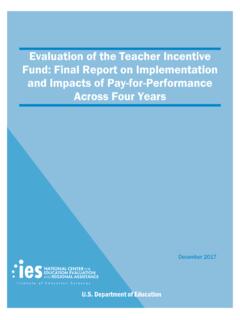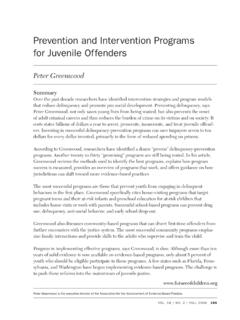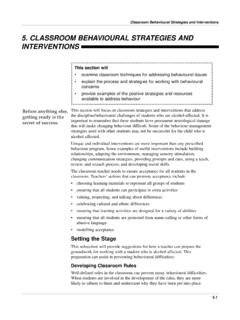Transcription of Peer-Assisted Learning Strategies (PALS)
1 Peer-Assisted Learning Strategies June 2012 Page 1 WWC Intervention Report DEPARTMENT OF EDUCATIONWhat Works ClearinghouseStudents with Learning Disabilities June 2012 Peer-Assisted Learning StrategiesReport ContentsOverview p. 1 Program Information p. 2 Research Summary p. 3 Effectiveness Summary p. 5 References p. 7 Research Details for Each Study p. 12 Outcome Measures for Each Domain p. 16 Findings Included in the Rating for Each Outcome Domain p. 17 Endnotes p. 20 Rating Criteria p. 21 Glossary of Terms p. 22 Program Description1 Peer-Assisted Learning Strategies (PALS) is a supplemental peer-tutoringprogram in which student pairs perform a structured set of activities in reading or math (PALS Reading and PALS Math, respectively). During the 30-35 minute peer-tutoring sessions, students take turns acting as the tutor, coaching and correcting one another as they work through problems. Pairs work together three or four times per week for reading sessions and two times per week for math sessions.
2 The designation of tutoring pairs and skill assignment is based on teacher judgment of stu-dent needs and abilities, and teachers reassign tutoring pairs PALS is for students with diverse academic needs, this inter-vention report focuses on the use of PALS to improve the reading and mathematics skills of students with Learning Two studies of PALS that fall within the scope of the Students with Learning Disabilities review protocol meet What Works Clearinghouse (WWC) evidence standards without reservations, and one study meets WWC evidence standards with reservations. The three studies included 100 students with disabilities from grades 2 6 in three states, with one of the study samples composed entirely of English language learners with Learning disabilities. Based on these three studies, the WWC considers the extent of evidence for PALS on students with Learning disabilities to be small for the reading fluency, reading comprehension, and mathematics domains.
3 Six other domains are not reported in this intervention report. (See the Effectiveness Summary for further description of all domains.)EffectivenessPALS was found to have potentially positive effects on reading fluency and reading comprehension and no discernible effects on mathematics for students with Learning 1. Summary of findings3 Improvement index (percentile points)Outcome domainRating of effectivenessAverageRangeNumber of studiesNumber of studentsExtent of evidenceReading fluencyPotentially positive effects+14+7 to +18260 SmallReading comprehensionPotentially positive effects+26+23 to +32260 SmallMathematicsNo discernible effects+9+8 to +10140 SmallPeer-Assisted Learning Strategies June 2012 Page 2 2 WWC Intervention ReportProgram InformationBackgroundDeveloped by Lynn Fuchs and Doug Fuchs in 1997, PALS is distributed by the Vanderbilt Kennedy Center for Research on Human Development. Address: Vanderbilt University, Attn: Flora Murray/PALS Orders, Peabody Box 228, Nashville, TN 37203-5701.
4 Email: Web: Telephone: (615) detailsPALS was designed to be used with all students in grades 2 6 as a supplement to the general education curriculum. Recently, PALS Reading has been extended to other grade levels, including K-PALS (kindergarten), First Grade PALS, and High School PALS. PALS Math also is available. PALS has been implemented by hundreds of teachers in Arizona, Iowa, Minnesota, Ohio, Oregon, Tennessee, Texas, and other states. The program has been used with English-proficient students with Learning disabilities and English language learners with and without Learning is a supplemental peer-tutoring program in which student pairs use a structured set of activities. Teachers first train their students in PALS procedures using training lessons from the teacher s manual. Then, student pairs are formed by teachers, and students alternate their roles as tutor and tutee. PALS activities vary for reading and math PALS Reading, the designation of tutoring pairs and the skill assignment to each pair are based on teacher judg-ment of student needs and abilities.
5 For grades 2 6, PALS Reading activities include Partner Reading/Retelling, Paragraph Shrinking, and Prediction Relay. In Partner Reading/Retelling, the stronger reader reads for five minutes, while the weaker reader serves as the coach by identifying errors, initiating correction procedures, and awarding points for each sentence read correctly. After the first student is finished reading, the coach asks the reader what he or she has learned. Students switch roles for the second five minutes and follow the same procedure. During Paragraph Shrinking, students generate main idea statements. The stronger reader reads one paragraph at a time. After reading each paragraph, the reader then determines the main idea. The tutor uses a correction procedure to help the reader correct main idea statements. After five minutes, the students switch roles with the second reader reading new material. During Prediction Relay, the stronger reader has two minutes to predict what he or she might learn or what might happen in each upcoming half-page segment.
6 After reading the segment, the reader has two minutes to evaluate the prediction. After five minutes, the students switch roles and follow the same procedure with new reading material for another five PALS Math, the designation of tutoring pairs and the skill assignment to each pair are based on teacher judgment or ongoing curriculum-based measurement data. For the second through sixth grades, PALS Math includes two activ-ities in each session. In the first activity, Coaching, the stronger student (the coach) models a series of questions to encourage the weaker student (the player) to internalize a self-talk method for solving computation or concepts/appli-cations problems. As the coach models this series of questions, the player answers questions and writes answers. The coach uses a set of helping and explaining Strategies to promote the player s understanding and to correct errors. The materials prompt the students when to switch coach and player roles.
7 The second activity, Practice, is a 5- to 10-minute activity that addresses the skill just practiced during coaching, as well as easier skills at that grade reading and mathematics activities are modified for kindergarten, first grade, and high school. Grade-appropriate materials and activities are A one-day PALS training workshop costs $1,000 to $1,500 plus travel for the trainer. Teachers manuals cost $40 each. Other materials available for purchase include a video, a DVD, and assorted grade-appropriate materials, all available for $15 to $44 per unit, depending on grade level and academic area. Additional information can be found on the Peer-Assisted Learning Strategies website ( ). Peer-Assisted Learning Strategies June 2012 Page 3 WWC Intervention ReportResearch SummaryForty-six studies reviewed by the WWC investigated the effects of PALS on students with Learning disabilities. Two studies (Fuchs, Fuchs, Phillips, & Hamlett, 1995; Saenz, Fuchs, & Fuchs, 2005) are randomized controlled trials that meet WWC evidence standards without reservations.
8 One study (Fuchs, Fuchs, Mathes, & Simmons, 1997) is a randomized controlled trial that meets WWC evidence standards with reservations. The remaining 43 studies do not meet either WWC eligibility screens or evidence standards. (See refer-ences beginning on p. 7 for citations for all 46 studies.)Summary of studies meeting WWC evidence standards without reservationsFuchs et al. (1995) examined the effects of PALS on the mathematics achievement of second- to fourth-grade stu-dents in nine schools in an urban school district in Tennessee. Teachers who had one or more students with Learning disabilities in their math class were recruited to participate in the study. This yielded a sample of 40 teachers who were each asked to identify three students to participate in the study: one low-performing student with a Learning disability (identified in accordance with state regulations), one low-performing student who did not have a Learning disability, and one average-performing student.
9 Teachers then were randomly assigned to either PALS or comparison conditions (20 teachers per group). This WWC review is based on an analysis of a subset of 40 students with Learning disabilities (20 PALS students and 20 comparison students). Comparison group teachers used their normal approach (business-as-usual). Outcome measures were administered immediately before and after the et al. (2005) examined the effects of PALS on the reading fluency and reading comprehension of third- to sixth-grade students in 12 English language learner (ELL) classrooms in one south Texas school district. To partici-pate in the study, a classroom had to have an all-ELL student population with at least two students with a Learning disability. The study design was a randomized controlled trial in which 12 classrooms were stratified on grade level and school. Each of the 12 teachers was then asked to identify 11 students to participate in the study: two low-achieving students with a Learning disability (identified in accordance with state regulations), three low-achieving students who did not have a Learning disability, three average-achieving students, and three high-achieving students.
10 After students were identified, the classrooms were randomly assigned to either PALS or comparison conditions (six per group). This WWC review is based on an analysis of a subset of 20 students with Learning disabilities (10 PALS students and 10 comparison students). Comparison group teachers conducted reading instruction using their normal approach (business-as-usual). Outcome measures were administered before and after the of study meeting WWC evidence standards with reservationsFuchs et al. (1997) examined the effects of PALS on reading fluency and reading comprehension of second- to sixth-grade students whose average age was ten. An initial sample of 22 schools from a southern state was strati-fied on reading scores and the percentage of students who qualified for free or reduced-price meals, and then randomly assigned (within strata) to either PALS or comparison conditions. After randomization of schools, teach-ers who had one or more students with Learning disabilities in their reading class were recruited to participate in the study.















